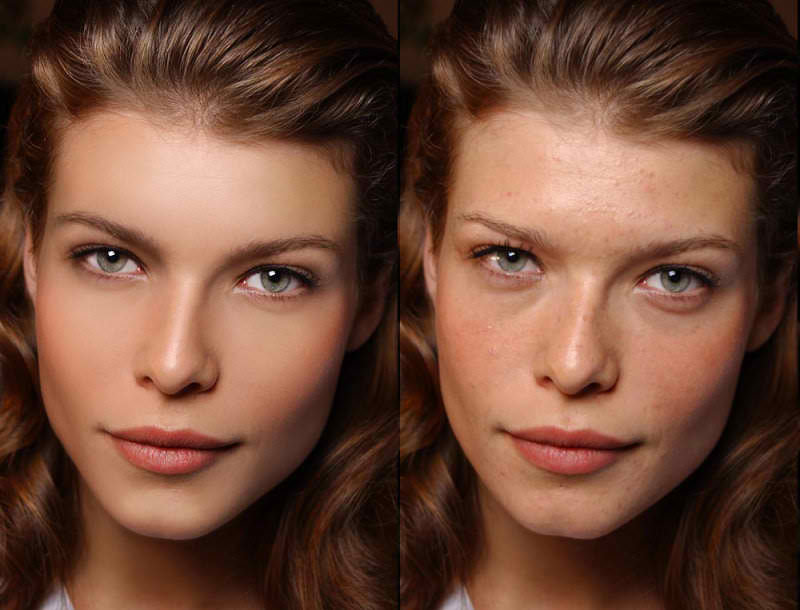
There are those of us who are born with average looks, and there are those who are genetically gifted. Folks with great bone structure, greater than average height and fast metabolisms have always had it a little easier in life. But even those people are trolls compared to the soulless aliens that grace our magazine covers and billboards. Here’s an in-depth look at the birth of a mutant.
Contrary to popular belief, even the most beautiful models must work extra hard to maintain their looks. Cocaine, salads and cigarettes just don’t cut it anymore. Aside from extensive body augmentation, these days supermodels live a disgustingly healthy lifestyle, full of nutritious food, supplements and abundant exercise. (Not to mention skin care, tanning, and other epidermic enhancements) Today’s real top models are what photoshopped people looked like 20-30 years ago. But the game has changed. Competition is fiercer than ever, and to stay ahead of the curve, you still have to go under the digital knife.
In the following video tutorial, you’ll see how Norwegian make-up artist turned retoucher Gry Garness dramatically changes the appearance of an already stunning model. And we’re not just talking blemishes and dark circles under the eyes here. Garness pulls apart the young woman, molds her into superhuman material, and puts her back together. Voila! She is now the object of desire and envy for every man and woman that comes across the ad.
We’ve all been somewhat aware of image manipulation in media and advertising over the years, but seeing it done, step by step brings some important things into perspective. First off, we can all breathe easy in realizing we’re not as ugly as we once thought. Secondly, we can confidently assume that this sort of image wizardry will never end. It will only grow more sophisticated as technology evolves. Lastly, now that we know the extent of the lie, to what degree do we keep buying into it? When does the majority say, “Enough is enough, I’m not purchasing that product anymore, and you shouldn’t either”? At the very least, the ads might be banned. But I don’t see the general public giving up their programmed dreams of living a certain lifestyle or owning beloved status symbols.

I might ad that I’m a bit of a hypocrite in this argument. I perform similar retouching on much of my portrait and commercial work, so I share the same taste in looking at a more “perfect” human, but here’s the flip-side to that coin: It’s often necessary to counter another lie. Although they’re pretty similar on the surface, Photography and Film/Video (or real-life for that matter) couldn’t be more remotely related. Even with zero post-processing or manipulation, Photography has essentially been a lie since its inception. It lets you see the world from an otherwise unattainable perspective. Frozen time. Let me explain:

The human eye can interpret anywhere from 15-60 frames per second for motion pictures. Anything more than that is usually overkill, and borders on uncomfortable. In photo-talk, that’s 1/15 to 1/60 of a second shutter speeds. Generally speaking, these speeds do not produce profound images when there is 1 or more moving subjects in the frame. Of course there are exceptions and niches for the aforementioned speeds. But for the most part, shooting anything that moves even slightly, requires using shutter speeds of 100th of a second or higher in order to “freeze” that shot or moment. Shooting professional sports requires shutter speeds to begin at 1/1000 or higher in order to prevent blurring of limbs, balls, golf clubs, or anything moving faster than a cat sleeping. We’re now in the realm of the unknown. Using these sophisticated cameras, we’ve been able to look at life in these infinitely minute slices that we otherwise wouldn’t ever see with the naked eye, no matter how hard we tried. It’s been a blessing and a curse.
In the following photo, we see a Ski Jumper at local competition in Vermont. This was shot at 1/2500th of a second. Anything less and the 60+mph Athlete would have been a complete blur. Freezing the skier at this speed makes him distinguishable. We can see that he is in fact human and suspended in mid air. The upward perspective makes him appear even more God-like. The sunlight bouncing off the snow gives him a distinct soft glow and separates him from the dark shed in the background. The overall effect is positive and awe inspiring. I may be inclined to purchase ATOMIC skis at some point to feel as heroic and capable as this man looks in this picture. I would never have been able to appreciate this small moment in time otherwise, so I stare at the image on my computer screen for 5-60 seconds. My eyes scan the subtle nuances over and over and commit them to memory.

The bad part about being able to freeze time is that we can also reveal unflattering details in people that you would otherwise go mostly unnoticed. The following shot of a young woman in New York’s Union Square is a good example. This photo was shot at 1/6400 of a second to combat the bright sunlight in conjunction with the large aperture I was using. The subject is isolated from a busy background, but we start to find lots of flaws. Her expression is strange. It looks like she may have been picking at a piece of food stuck in her teeth, or posing for a photo-op on the Jersey Shore. Either way, it’s not flattering. It makes her look arrogant, or bitchy, or whatever other negative personality trait comes to mind. Her posture is captured at the least attractive moment of a stride. it makes her look heavier than she might be. There’s also a loose bit of fat peaking out of the inside of her left thigh. The harsh sun is casting awkward shadows on her face and neck. Etc, etc. She is surely more attractive in real life, or on video, but when we stare at this 1/6400th of a second photo for 5-60 seconds, we’re experiencing these flaws by up 75-3600% more than we would in real life.

It wouldn’t be fair to judge this young woman based on 1/6400 of a second. We never experience anyone that way. In real life, people are constantly moving, breathing, shifting, scratching. There is eye contact, humorous conversation, charm, and a host of other pleasant human traits that distract from physical flaws. It’s why we fall in love, shack up together and make babies. We can see past physical flaws and into the best possible self of others.
From the perspective of a portrait photographer, it is desired to produce a frozen image of someone that reflects their best possible self. We need to make an image that not only showcases their positive physical attributes, but also conveys a warm or welcoming personality. This means that we have to counter our original lie, photography, with the lies of retouching and flattering lighting. We’re justifying the disservice of freezing someone in two dimensions with a magic eraser. In a sense, we’re leveling the playing field and neutralizing how people are perceived in non-reality.
We’re making a right with two wrongs.
But in the case of commercial advertising, we’re being sold something else. The perfect body and face come with the programmed personality that sells the dream you need to buy to make your life worth living again.

I feel so much prettier now. . . and I’m a old fart guy! 🙂